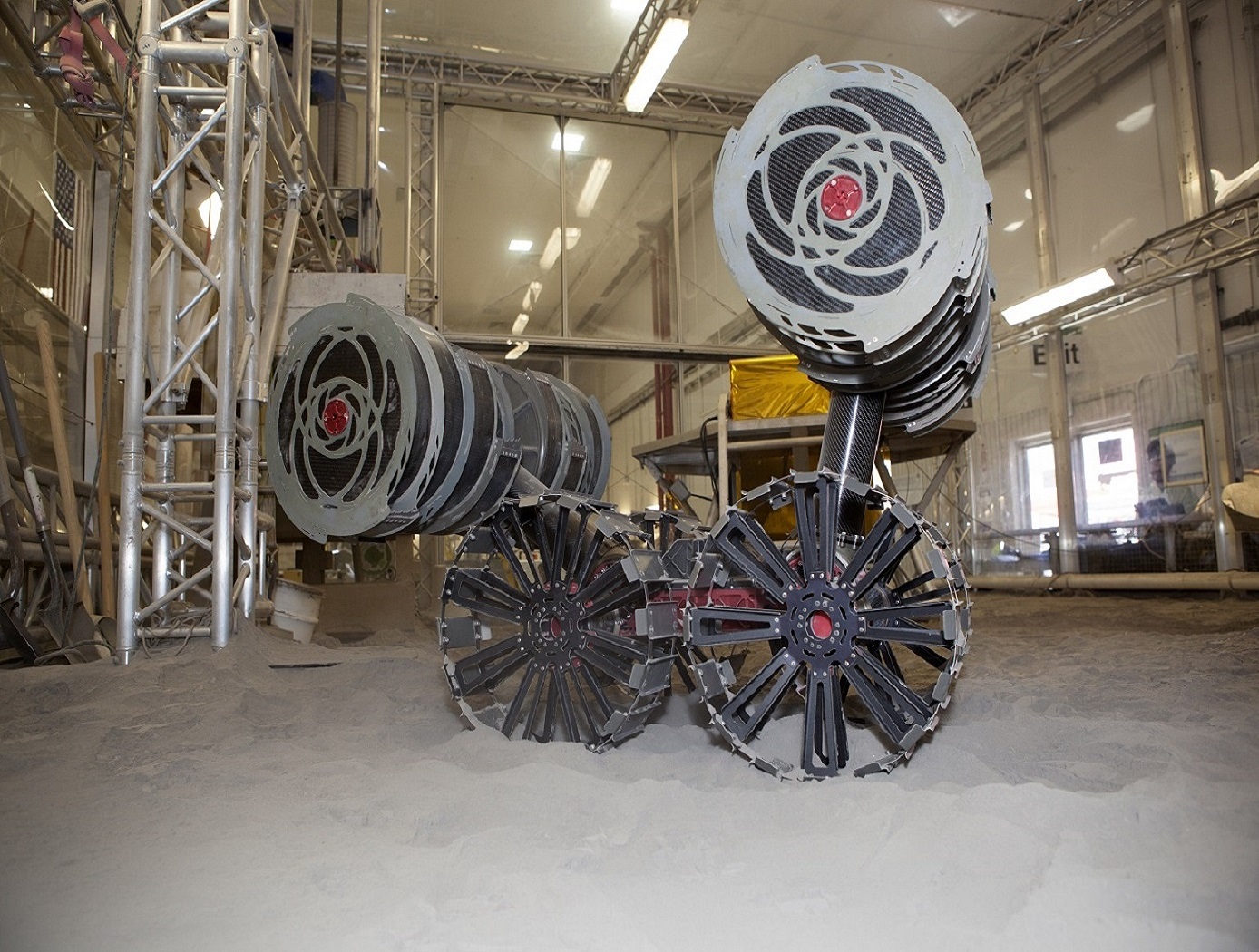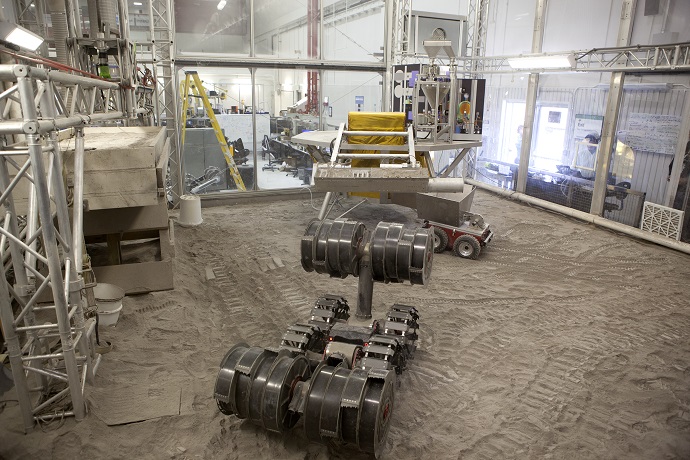Regolith Advanced Surface Systems Operations Robot (RASSOR) Excavator
Robotics Automation and Control
Regolith Advanced Surface Systems Operations Robot (RASSOR) Excavator (KSC-TOPS-7)
Unique Robot Excavates In Space And On Earth
Overview
NASA Kennedy Space Center seeks partners interested in the commercial application of the Regolith Advanced Surface Systems Operations Robot (RASSOR) Excavator. NASAs Kennedy Space Center is soliciting licensees for this innovative technology.
RASSOR is a teleoperated mobile robotic platform with a unique space regolith excavation capability. Its design incorporates net-zero
reaction force, thus allowing it to load, haul, and dump space regolith under extremely low gravity conditions with high reliability. With space transportation costs hovering at approximately $4,000 per pound and tight launch vehicle shroud constraints, this compact, lightweight unit enables the launch of an efficient, rugged, versatile robotic excavator on precursor landing missions with minimum cost. RASSOR could also be scaled up and used for terrestrial mining operations in difficult-to-reach or dangerous locations.
The Technology
Regolith excavation is desired in future space missions for the purpose of In Situ Resource Utilization (ISRU) to make local commodities, such as propellants and breathing air, and to pursue construction operations. The excavation of regolith on another planetary body surface, such as the Moon, Mars, an asteroid, or a comet is extremely difficult because of the high bulk density of regolith at lower depths. Additionally, because of the low gravity in these space surface environments, the mass of the excavator vehicle does not provide enough reaction force to enable the excavation blade to penetrate the regolith if traditional terrestrial methods are used.
RASSOR uses counterrotating bucket drums on opposing arms to provide near-zero horizontal and minimal vertical net reaction force so that excavation is not reliant on the traction or weight of the mobility system to provide a reaction force to counteract the excavation force in low-gravity environments. The excavator can traverse steep slopes and rough terrain, and its symmetrical design enables it to operate in reverse so that it can recover from overturning by continuing to dig in the new orientation. The system is capable of standing up in a vertical position to dump into a receiving hopper without using a ramp. This eliminates the need for an onboard dump bin, thus reducing complexity and weight.
During loading, the bucket drums excavate soil/regolith by scoops mounted on the drums exteriors that sequentially take multiple cuts of soil/regolith while rotating at approximately 20 revolutions per minute. During hauling, the bucket drums are raised by rotating the arms to provide clearance above the surface being excavated. The mobility platform can then travel while the soil/regolith remains in the raised bucket drums. When the excavator reaches the dump location, the bucket drums are commanded to reverse their direction of rotation, which causes soil/regolith to be expelled out of each successive scoop. RASSOR has wireless control, telemetry, and onboard transmitting cameras, allowing for teleoperation with situational awareness. The unit can be programmed to operate autonomously for selected tasks.


Benefits
- Weight/Space Efficient - Lightweight materials and foldable design reduce launch weight and payload dimensions
- Low-Gravity-Capable - Design provides near-zero horizontal and minimal vertical net reaction force, enabling operation in extremely low gravity conditions.
- Versatile - Platform can traverse steep slopes and rough terrain, and reversible design allows continued operation even if unit is overturned. Wireless control, telemetry, and onboard cameras provide teleoperation and situational awareness.
- Dependable - Minimalist design approach reduces complexity and parts count for higher platform reliability and maintainability. Design also incorporates a high strength-of-materials safety factor.
- Scalable - Platform design can be scaled up or down to meet project requirements. Smaller sizes are suitable for space missions; larger designs could be used for terrestrial mining in hazardous or hard-to-reach locations.
Applications
- Extraterrestrial In Situ Resource Utilization (ISRU)
- Extraterrestrial Construction Operations
- Space Mining of Regolith and Water Ice
- Robotic Terrestrial Mining Operations
- Autonomous and Teleoperated Sand Mining
Technology Details
Robotics Automation and Control
KSC-TOPS-7
KSC-13664
KSC-14032
IEEE Big Sky 2013, Regolith Advanced Surface Systems Operations Robot (RASSOR), 03/02/2013
|
Related Links:
|
Similar Results

Robotic system for assembly and maintenance of lightweight reconfigurable structures
To enable the goal of autonomous assembly of high performing structures, a robot system must be able to travel across a lattice structure in all dimensions, transport and align a unit cell module to the correct location and fasten the module to the existing structure. In this system, a team of multiple mobile bipedal robots work together to carry, transfer, and place 3D-lattice modules (e.g., cuboctahedron voxels) to form a 3D lattice structure. The team of mobile bipedal robots autonomously provide transportation, placement, unpacking, and assembly of voxel modules into functional structures and systems. As the team of mobile bipedal robots live and locomote on the 3D-lattice structure, they monitor health and performance, enabling repair and reconfiguration when needed. The mobile bipedal robots work together in different roles, for example, one as a cargo transport robot and the other as a crane robot. The cargo transport robot and the crane robot work together to move the voxels from one location to another. Each robot includes at least one electronic control module that receives commands from another robot or a central control system. A central control system implements a plan to control the motion sequences of the robots to maximize efficiency and to optimize the work required to completely assemble a structure. The plan is pre-computed or computed during implementation by the central control system or the robots themselves, according to algorithms that utilize the regularity of the lattice structure to simplify path planning, align robotic motions with minimal feedback, and minimize the number of the degrees of freedom required for the robots to locomote across and throughout the 3D-lattice structure and perform structural assembly.

Lunar Surface Manipulation System
NASA Langley developed the LSMS because of the need for a versatile system capable of performing multiple functions on the lunar surface, such as unloading components from a lander, transporting components to an operational site and installing them, and supporting service and replacement during component life. Current devices used for in-space operations are designed to work on orbit (zero g) only and thus do not have sufficient strength to operate on planetary surfaces. Traditional cranes are specialized to the task of lifting and are not capable of manipulator-type positioning operations.
The innovations incorporated into the LSMS allow it to lower payloads to the ground over a significant portion of the workspace without use of a hoist, functioning like a robot manipulator, thus providing a rigid connection and very precise control of the payload. The LSMS uses a truss architecture with pure compression and tension members to achieve a lightweight design. The innovation of using multiple spreaders (like spokes in a wheel) allows the LSMS to maintain its high structural efficiency throughout its full range of motion. Rod portions of the tension members automatically lift off and re-engage the spreaders as the joint articulates, allowing a large range of motion while maintaining mechanical advantage. In addition, the LSMS uses a quick-change device at the tip end that enables automated acquisition of end effectors or special purpose tools to increase its versatility.

Robonaut 2: Logistics and Distribution
R2 was designed to work side-by-side with people and to be sensitive to its surroundings. The robot's advanced vision systems and recognition processing can quickly recognize a person in its path and take the appropriate action. If the robot comes into contact with a person or piece of equipment, it gives. There is no need to design specialized equipment for R2 because the robot has the ability to operate equipment and machines designed for humans, like hand-held power tools. R2 has the capability to improve the speed and accuracy of operations while maintaining sensitivity to its surroundings, making the robot prime for the logistics and distribution environment.
R2 was designed to handle unexpected objects coming into its path since it has to function in space where not everything is locked down. The robot has the ability to move in unconventional ways as compared to existing robots. Robonaut 1, an earlier version of R2, was integrated with a two-wheeled Segway personal transporter, giving it a range of motion. R2 has the capability of being integrated onto a two-wheeled base or a more rugged four-wheel base. An adaptable interface would enable R2 to integrate with other surface mobility systems.
This NASA Technology is available for your company to license and develop into a commercial product. NASA does not manufacture products for commercial sale.

Modular Robotic Vehicle (MRV)
The Modular Robotic Vehicle (MRV) is a vehicle designed for transportation in congested areas. The MRV is relatively small, easy to maneuver and park. The MRV was designed without a central power plant, transmission, fuel tank, and direct mechanical linkages between driver input devices and the actuators used to accelerate, brake and/or steer the car. These core vehicle functions are located at the corners of the vehicle in a modular electric corner assembly or eCorner. Because the MRV uses a by-wire control system, substantial space and weight is conserved compared to conventional designs. Moreover, the functional capabilities that are provided by the individual eCorners enable control of the vehicle in a variety of different operating modes.
The eCorners provide significant flexibility in driving options. For example, the driving mode can be switched so that all four wheels point and move in the same direction achieving an omni-directional motion or all wheels can be pointed perpendicular to the center of the vehicle allowing rotation around its center axis. This mode makes some driving maneuvers like parallel parking as easy as driving next to the spot, turning the wheels 90 degrees, and driving into the open spot in a sideways motion. Each eCorner includes its own redundancy to protect for electrical failures within the systems. The driver can choose to control the vehicle with a conventional steering wheel or add inputs through a multi-axis joystick for additional control in some of the more advanced drive modes. The vehicle has the propulsion motors located inside of each eCorner with the capability of producing 190 ft-lbs of torque with a current top speed of 40 mph. An active thermal control loop maintains the temperatures of these high powered motors and a separate thermal loop cools the avionics and the custom lithium-ion battery packs. The linked vehicles are able to exchange or share control data and electrical power. Finally, the MRV has remote driving control capability.

Robonaut 2: Industrial Opportunities
NASA, GM, and Oceaneering approached the development of R2 from a dual use environment for both space and terrestrial application. NASA needed an astronaut assistant able to function in space and GM was looking for a robot that could function in an industrial setting. With this in mind, R2 was made with many capabilities that offer an enormous advantage in industrial environments. For example, the robot has the ability to retool and vary its tasks. Rather than a product moving from station to station on a conveyor with dozens of specialized robots performing unique tasks, R2 can handle several assembly steps at a single station, thereby reducing manufacturing floor space requirements and the need for multiple robots for the same activities. The robot can also be used in scenarios where dangerous chemicals, biological, or even nuclear materials are part of the manufacturing process.
R2 uses stereovision to locate human teammates or tools and a navigation system. The robot was also designed with special torsional springs and position feedback to control fine motor movements in the hands and arms. R2's hands and arms sense weight and pressure and stop when they come in contact with someone or something. These force sensing capabilities make R2 safe to work side-by-side with people on an assembly line, assisting them in ergonomically challenging tasks or working independently.
This NASA Technology is available for your company to license and develop into a commercial product. NASA does not manufacture products for commercial sale.



